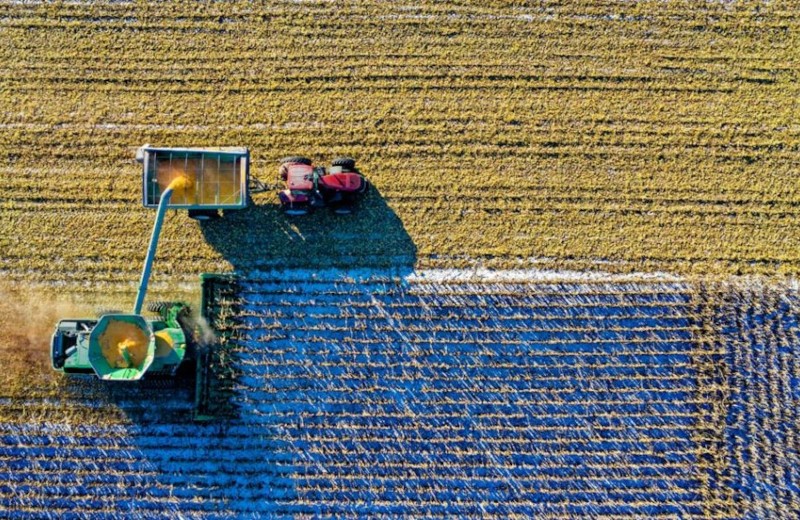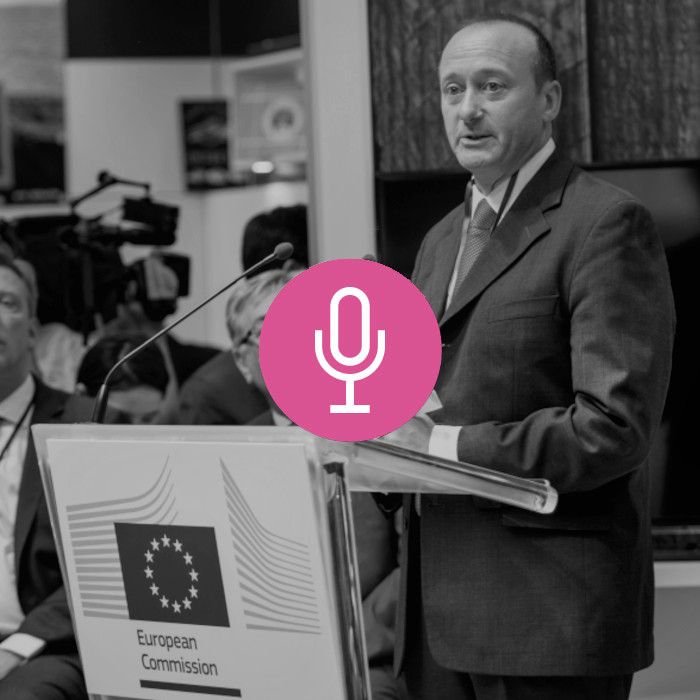Table of Contents
The new EU biodiversity strategy embodies a vision of 'ecologically sustainable' farming
The European Commission’s new biodiversity strategy embodies a particular vision of farming which is ecologically sustainable rather than the production-maximisation emphasis of the early decades of the Common Agricultural Policy. The document states that ‘certain agricultural practices are a key driver of biodiversity decline. This is why it is important to work with farmers to support and incentivise the transition to fully sustainable practices. Improving the condition and diversity of agroecosystems will increase the sector’s resilience to climate change, environmental risks and socioeconomic shocks, while creating new jobs, for example in organic farming, rural tourism or recreation.’
There is concern about the continuing reliance on chemical pesticides in EU member states
As part of the Farm to Fork Strategy the Commission will take action to reduce by 50 per cent the overall use of – and risk from – chemical pesticides by 2030 and halve the the use of the more hazardous pesticides by 2030.
Biological technologies offer a way forward...
Biological technologies offer a way forward as the availability of chemical pesticides is reduced. And they have a key but specific role to play in crop protection. Synthetic chemical pesticides are a precious resource for crop protection and should be treated as such. However, the occurrence of human and environmental harm (because of misuse or overuse of pesticides), problems of resistance to pesticides and the withdrawal of some products means that fewer chemical pesticides are available in the market. Alternative crop protection tools are needed and biological technologies have an increasing and important role to play, especially as part of Integrated Pest Management (IPM) programmes. The EU’s Farm to Fork Strategy specifically supports wider implementation of IPM.
It is important to note that microbial pesticides use natural enemies that are endemic, (i.e., that already occur naturally in the country or region of use). Permanent establishment is not a feature and the population of the released agent is expected to decline to background levels after application. Any negative effects on non-temporary species should be temporary. Regulatory screening ensures that there are no negative effects on human or animal health or the environment.
But they are impeded by regulatory hurdles
The wider use of biological technologies has been impeded by regulatory hurdles that arise from asking questions that are not relevant for biological as distinct from chemical products. They have mostly been used in the protected crops sector where, for example, using chemicals instead would kill pollinating bees. They do require greater management by farmers and growers and they are often less instantaneously efficacious. This undoubtedly influences the willingness of farmers to adopt them – and most of the agronomists who advise farmers sell chemical products.
Even so, the market share for biological technologies has grown from virtually nothing in 1993 to US$ 4 billion in 2018, in a span of 15 years; forecasts suggest that their share will double and reach US$ 8 billion within the next five years. Of the different technologies globally available in 2018, microorganisms continue to dominate with 53% of the market, biochemicals 39% and macrobials 7%. There has been some consolidation in the industry, with multinational agrochemical companies such as Bayer, BASF and Syngenta and smaller multinational companies such as Certis having been brought into the sector by acquiring smaller companies. Individual spin-outs and start-ups have also been acquired by larger companies or by venture capital. In the past, there were allegations that large agrochemical companies slowed down the sector, but now they see biocontrol as having great potential for further growth.
The EU approval system for plant protection products was originally designed to cater for synthetic or conventional chemical pesticides. The effect of the influence of conventional pesticides is found at all layers of the system because it was developed by and for them. Many of its procedures, or the questions that could be asked of applicants, were irrelevant for biocontrol products, for example, asking questions about the physical-chemical properties such as the boiling point of a microorganism but not asking about their biological properties.
The majority of the companies researching and developing these products are micro enterprises, typically a spin-off from a university on a science park or innovation start-up. Staffed by scientists, they have limited understanding of the political process and few spare resources to devote to lobbying. They often find the checks and balances of regulation baffling and restrictive. They have lacked the political influence of the big agrochemical companies, although that is now available to the sector. Developing an effective representational structure for the emerging biopesticides industry took some time and continues to do so, but the International Biocontrol Manufacturers Association (IBMA) has undergone a constant process of development. Even so, a regulatory barrier was created to the entry of more of these sustainable products on to the market.
The biggest challenge that biopesticide manufacturers have faced in moving the debate forward has been the lack of a clear political constituency of support and hence of cohesive advocacy for biological technologies. Relatively few broad acre farmers have used them so there has been relatively little pressure from farming organisations for their wider availability (although the importance of the greenhouse sector creates a somewhat different political context in countries such as the Netherlands). In the United Kingdom, for example, National Farmers Union (NFU) policy for integrated pest management (IPM) appears to be strongly influenced by and embedded in the use of agrochemicals. Farmers are subtly persuaded that they will fail if they do not have conventional chemistry and this is used to influence the conversation about what crop protection solutions will look like. The potentially influential organic sector is not really a source of support as they are suspicious of biological technologies or ‘biopesticides’ on the grounds that they are ‘still pesticides’. That is why the ecological focus of the new strategy is important as it should provide a favourable context for biocontrol developers.
In the EU, microbial, biochemical and semiochemical biological technologies are registered under the same regulatory framework as chemical pesticides although some special provisions have been developed. The legislation provides for measures that favour the registration of products defined as ‘low risk’ (most of the biological technologies) but the process has not worked well in practice. Although ‘biological technologies or biopesticides’ do not exist as a regulatory category, the pesticide categories ‘basic substances’ and ‘low risk substances’ were introduced in August 2017, as defined in Regulation 2017/1432, amending Regulation 1107/2009.
Before plant protection products (PPP) could be introduced to the European market, the active substance must be approved for the EU, after which authorisation of the product can be sought in individual Member States. For the approval of an active substance, the applicant submits a dossier to an individual Member State, the Rapporteur Member State. The Rapporteur Member State produces a draft assessment report, which is submitted to the European Commission and the EFSA which is responsible for peer reviewing the risk assessments of active substances. Finally, the European Commission presents a review report to the Standing Committee for Food Chain and Animal Health (SCFCAH), who votes on approval or non-approval of the active substance.
It should be noted that the resources available to regulatory bodies in the Member States vary considerably and this in turn affects their competence and reputation. As a broad generalisation, those in Northern Europe and one or two Member States in Central Europe are the most innovative, while those in the rest of Central and Southern Europe have more limited capacity. This is reflected in the Member States that have invested in capacity for evaluating microbial active substances.
Under the current regulatory system (in Reg. (EC) 1107/2009), and depending on the complexity and completeness of the dossier, it takes 2.5–3.5 years to approve a new active substance. The subsequent authorisation of a product is carried out by the Member States, with the applicant specifying the Member State carrying out the evaluation, which takes a further 1.5–2 years. Following authorisation, a company may apply for mutual recognition within one of the three geographic zones (North, Central and South) for products with the same use(s) under similar agricultural conditions. The approval process takes the same time regardless of the type of active substance or the dossier size (e.g. the majority of biopesticide dossiers contain about 10% of the paperwork of a conventional pesticide). Biopesticide dossiers are smaller because they usually do not trigger the need for higher level studies, for example, for many biopesticides a reasoned case can be provided to justify the lack of relevant residues whereas extensive studies are needed for most conventional pesticides.
The regulatory system is not facilitating the registration of biological technologies
In the EU, over 30% of approved active substances are now biological technologies. Yet, with one or two Member States as exceptions, the problems within the EU regulatory systems for ‘alternative’ active substances and products are similar to those in many other regions or countries:
- Lack of specific data requirements for this new class of products
- Limited knowledge and experience within government regulatory agencies
- Lack of government financial support to regulatory agencies to build their capacity
- No mechanisms for a fast track system for products that are, in the main, inherently less harmful to humans and the environment
Biological technologies should be regulated. Just because something is natural does not mean it is safe. However, the regulatory system has tended to follow a chemical pesticide model that does not facilitate the efficient registration of biological technologies.
A successful biocontrol product – T34 Biocontrol and Xilon
This was originally developed by a spin out company from the University of Barcelona, but is approved for use in the UK. It was originally intended to be for Fusarium management in ornamentals, then expanded to field grown lettuce. In partnership with an Austrian company it has been developed as a seed treatment for maize, sunflowers, soyabean and oil seed rape. In all these cases it is used at a lower rate than in horticulture and gives good disease and mycotoxin reduction.
The active substance is Trichoderma asperellum strain T34. T34 Biocontrol is used as a growing media drench in horticulture or by irrigation and Xilon is applied as granule into furrows or sprays to soil at planting. T34 Biocontrol can be used in greenhouses and for salad and leafy vegetable crops outdoors. Xilon is for managing diseases in field crops. The efficacy of T34 Biocontrol is an average kill rate of 63 per cent (better than other biologicals) and compared to an average of 77 per cent for the chemical standard. The efficacy of Xilon is comparable to or the same as the standard chemical product, including reduction of mycotoxin levels.
Glossary
Integrated pest management (IPM) is an ecologically based pest control strategy that relies heavily on natural mortality factors such as natural enemies and weather and seeks out control tactics that disrupt these factors as little as possible. Pesticides are used sparingly and all possible pest control tactics are considered, including no action. The potential interaction among various control tactics is evaluated.
- Macrobials are commonly known as beneficial insects, e.g., ladybirds consume aphids.
- Microbials are single cell organisms. Microorganisms used as control agents of agricultural pests include bacteria and fungi, also protozoa and viruses.
- Mycotoxins are toxic compounds that are naturally produced by fungi and are capable of causing disease and death in humans and other animals.
- Semiochemical is a chemical substance released by an organism that can, for example, disrupt insect mating behaviour.
Further reading
A Bailey et al Biopesticides: Pest Management and Regulation (CABI International, 2010).
N Birch and T Glare (eds) Biopesticides for Sustainable Agriculture (Burleigh Dodds, 2020).
D Chandler et al, ‘Microbial biopesticides for integrated crop management: an assessment of environmental and regulatory sustainability’, Trends in Food Science and Technology, 19 (2008), 275-83.
W Grant and J Greaves, ‘Underperforming Policy Networks: the Biopesticides Policy Network in the United Kingdom’, British Politics, 5 (1) (2010) 14-40.
Wyn Grant is is a British political scientist and professor of politics at the University of Warwick. He was chair and president of the Political Studies Association.




